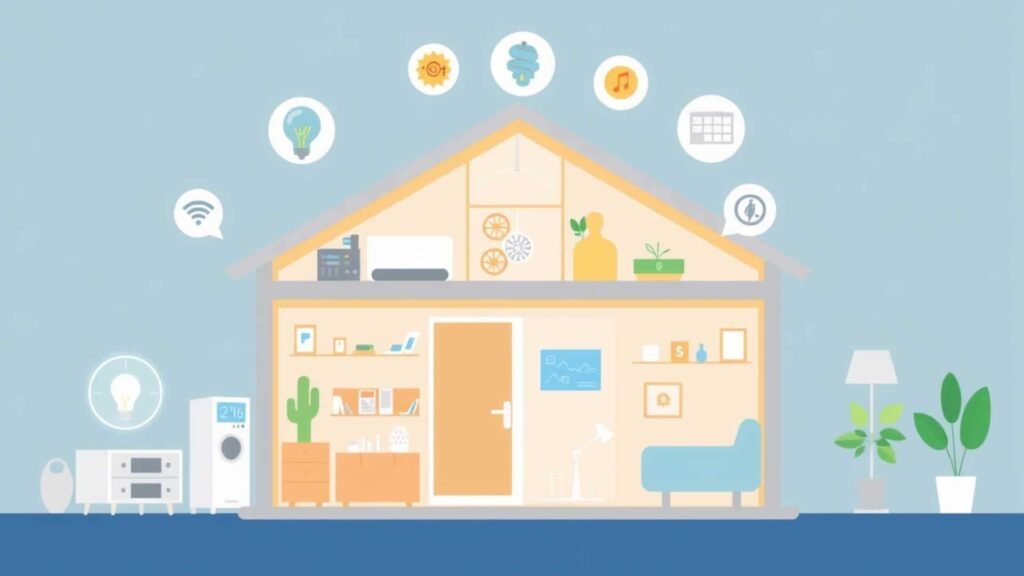Smart Home Savings are more than just a buzzword—they’re a practical way to reduce monthly expenses while upgrading your living space. With energy prices rising and household budgets tighter than ever, investing in the right technology can help you cut costs and simplify your everyday routine.
In this guide, we’ll highlight five smart home devices that actually make a difference. These aren’t just trendy tech tools—they’re functional upgrades designed to lower your bills, save energy, and give you more control over your home. Let’s dive into the smart finds that bring true value.
Why Smart Home Savings Matter
Home automation isn’t just about convenience—it’s also about making your space work smarter, not harder. When chosen wisely, smart gadgets can help you:
- Reduce electricity and water waste
- Optimize heating and cooling usage
- Monitor and manage energy in real time
- Avoid overpaying for utilities or repairs
- Spend less time on repetitive tasks
Now let’s explore five of the most reliable and cost-effective smart home products available in 2025.
1. Smart Thermostat – Control Energy, Cut Costs
Heating and cooling account for nearly half of a typical home’s energy bill. A smart thermostat helps reduce those costs by learning your schedule, detecting when you’re away, and adjusting temperatures automatically.
Featured product:
Google Nest Thermostat – This sleek device is compatible with most HVAC systems and can help save up to 15% on energy bills.
Why it’s a smart home savings essential:
- Adjusts temperature based on your habits
- Offers energy reports and suggestions
- Can be controlled from anywhere via app
Imagine warming your house before you even walk through the door—without wasting energy when you’re not home.
2. Smart Plugs – Power Only When You Need It
We often forget how many devices stay plugged in and draw power even when not in use. Smart plugs solve this by letting you control when your appliances turn on and off.
Featured product:
Kasa Smart Plug – Easy to set up, these plugs work with Alexa and Google Assistant and include scheduling and energy monitoring features.
Daily cost-cutting benefits:
- Turn off devices automatically at night
- Schedule lights or coffee makers
- Monitor power usage per device
These tiny tools pack a punch when it comes to long-term energy and money savings.
3. Smart LED Bulbs – Bright Ideas for Your Wallet
LEDs already use less energy than traditional bulbs, but smart LED bulbs take it further with scheduling, motion detection, and remote control.
Featured product:
Philips Hue White & Color Ambiance Bulbs – These Wi-Fi-enabled bulbs offer full customization and pair with voice assistants.
Why it saves you money:
- Turn off lights remotely to avoid waste
- Dim or schedule lights for specific times
- Use sensors to illuminate only when needed
You’ll not only save on your electric bill—you’ll also add mood and flexibility to your lighting setup.
4. Smart Water Leak Sensor – Prevent Damage Before It Costs You
Water leaks are one of the most expensive and stressful home issues. A smart leak detector helps you catch problems before they turn into major repair bills.
Featured product:
Govee WiFi Water Leak Detector – Affordable and reliable, this sensor alerts you instantly via app if water is detected near sinks, washers, or pipes.
How it protects your budget:
- Prevents expensive water damage
- Sends alerts before a leak escalates
- Peace of mind for basements and laundry rooms
One small sensor could save you thousands in repair costs.
5. Smart Power Strip – Efficient Charging & Control
Unlike basic surge protectors, smart power strips allow individual outlet control, schedule settings, and energy tracking—great for entertainment centers or home offices.
Featured product:
Kasa Smart Plug Wi-Fi Power Strip – With six outlets and two USB ports, this device monitors and manages each port through a mobile app.
Smart home savings advantages:
- Cuts phantom power draw from electronics
- Turns off unused devices with a single tap
- Offers insight into your energy consumption
This is especially useful for reducing hidden energy use in high-tech areas of your home.
How to Choose the Right Smart Devices for Savings
Focus on High-Use Areas
Start where you spend the most money—typically heating, lighting, and plugged-in electronics. Replacing older devices in these categories will generate noticeable savings.
Prioritize Compatibility and Ease of Use
Look for gadgets that work with your current home setup and preferred voice assistant (like Alexa or Google). Devices that are easy to control are more likely to be used consistently.
Combine Devices for Greater Impact
Using multiple smart gadgets together amplifies your savings. For example, pairing a smart thermostat with smart plugs and bulbs creates a synchronized system that automatically reduces unnecessary energy use.
Real-Life Benefits of Smart Home Savings
Here’s how real homeowners are benefiting from these tools:
- Maria, a mom of two, saw her electricity bill drop 20% after installing a Nest Thermostat and a few smart bulbs.
- Jake, a remote worker, set his smart power strip to turn off his home office automatically at night, saving $10/month.
- Carmen and Leo, renters in a small apartment, installed a smart plug and leak sensor to prevent waste and protect their deposit.
These are simple but powerful examples of how a few smart decisions lead to long-term results.
Conclusion: Make Smart Choices That Pay Off
You don’t need to overhaul your entire home to benefit from smart home savings. Start small—pick one or two of the gadgets mentioned above and track the difference. Over time, those little changes can lead to noticeable reductions in your bills and stress levels.
By integrating smart devices into your daily routine, you’ll gain more control, waste less, and create a home that supports your lifestyle and your wallet.
Want to enhance your home experience even further?
Check out our related post:
“10 Smart Kitchen Hacks You’ll Wish You Knew Sooner”

